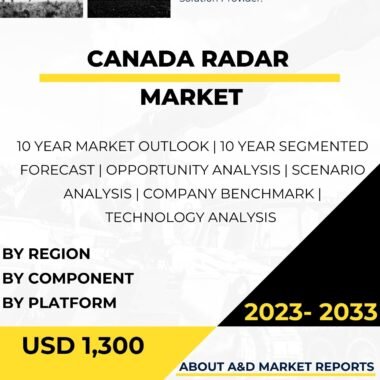Description
United States Antenna, Transducer and Radome Market
United States Antenna, Transducer and Radome are essential components of modern communication, radar, and sensing systems. These technologies play a crucial role in enabling wireless communication, satellite connectivity, radar detection, sonar systems, and many other applications. This article will explore the development, types, applications, and significance of antennas, transducers, and radomes in various industries and sectors.
Antennas are devices used to transmit and receive electromagnetic waves, allowing wireless communication between devices and networks. The development of antennas dates back to the late 19th century when pioneering scientists like Guglielmo Marconi and Nikola Tesla made significant contributions to wireless telegraphy and radio communications.
Today, antennas come in various forms and sizes, ranging from simple whip antennas used in handheld devices to complex phased array antennas employed in advanced radar and communication systems. The choice of antenna depends on the specific application’s requirements, such as frequency range, gain, directivity, and environmental factors.
One of the most common types of antennas is the dipole antenna, consisting of two conductive elements connected to a radio-frequency (RF) transmitter or receiver. Dipole antennas are widely used in radio and television broadcasting, wireless communication networks, and portable devices like smartphones and Wi-Fi routers.
Directional antennas, such as Yagi-Uda antennas, provide higher gain and focused radiation patterns, making them suitable for point-to-point communication and long-range links. These antennas are commonly used in satellite communication, radar systems, and wireless backhaul networks.
Phased array antennas are highly versatile and electronically steerable antennas used in radar, communication, and aerospace applications. By controlling the phase of the signals across multiple antenna elements, phased array antennas can steer the radiation beam in different directions without physically moving the antenna.
In the United States, antennas are critical in supporting the country’s vast communication infrastructure, including cellular networks, satellite communication, and terrestrial broadcasting. The demand for high-speed data transmission, increased network capacity, and ubiquitous connectivity drives ongoing research and development efforts to advance antenna technology.
Transducers are devices that convert one form of energy into another. In the context of the United States, transducers play a vital role in converting electrical signals into other types of energy, such as acoustic waves in sonar systems or mechanical vibrations in sensors.
In the field of acoustics, piezoelectric transducers are widely used in sonar and ultrasound applications. These transducers convert electrical signals into acoustic waves and vice versa, enabling underwater communication, depth sounding, and medical imaging.
Another significant application of transducers is in sensors and actuators used in various industries, including automotive, aerospace, and manufacturing. Sensors convert physical parameters, such as temperature, pressure, and strain, into electrical signals for monitoring and control purposes. Actuators, on the other hand, use electrical signals to generate mechanical motion or perform a specific action.
In the United States, transducer technology finds diverse applications across industries, such as medical imaging, automotive sensing, industrial automation, and consumer electronics. Advancements in transducer materials, miniaturization, and signal processing have led to the development of highly sensitive and accurate sensors and actuators.
Radomes are protective enclosures that cover antennas or transducers, providing mechanical support and protecting them from environmental factors like wind, rain, and ice. Radomes are designed to be transparent to the electromagnetic waves used by antennas and transducers, ensuring minimal impact on signal transmission and reception.
In the field of aviation, radomes are commonly used to house weather radar systems and other communication antennas on aircraft. These aerodynamically shaped enclosures reduce drag and enable radar and communication systems to operate effectively even at high speeds and altitudes.
Radomes are also employed in satellite communication systems to protect the sensitive antennas and transducers from the harsh space environment. These radomes are designed to withstand extreme temperatures, radiation, and micrometeoroid impacts while maintaining excellent transmission characteristics for the electromagnetic signals.
The U.S. defense sector relies heavily on radomes to protect the antennas and transducers used in radar, surveillance, and communication systems on military aircraft, ships, and ground-based installations. The ability of radomes to preserve the integrity and performance of critical electronic systems in challenging environments enhances the operational capabilities of the U.S. armed forces.
The development of advanced materials and manufacturing processes has contributed to the evolution of radome technology. Radomes made from materials like fiberglass, carbon fiber composites, and radar-absorbing materials offer superior durability, reduced weight, and improved electromagnetic properties.
In conclusion, antennas, transducers, and radomes play essential roles in enabling wireless communication, radar detection, sensing systems, and various other applications in the United States. Antennas facilitate the transmission and reception of electromagnetic waves in a wide range of communication and radar systems. Transducers convert energy from one form to another, enabling the detection of physical parameters and the generation of mechanical motion. Radomes provide protective enclosures for antennas and transducers, ensuring their proper functioning and longevity in harsh environmental conditions.
In the U.S., these technologies find applications in sectors such as telecommunications, aerospace, defense, automotive, medical imaging, and industrial automation. As technology continues to advance, ongoing research and development efforts focus on improving antenna performance, transducer sensitivity, and radome durability. The continued innovation in antennas, transducers, and radomes is critical in meeting the growing demand for high-speed communication, accurate sensing, and reliable radar systems in the United States and worldwide.




